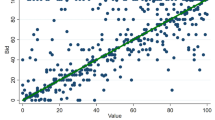Abstract
We simulate a multiagent market with production, consumption, and exchange mediated by a sealed-bid double auction. Marked price bubbles and subsequent crashes occur when value-based (fundamentals-driven) and trend-based traders are both present, and the market equilibrium price is ramped up exogenously. Similarly, negative price bubbles and recoveries occur when the equilibrium price is ramped down. Because the simulated market is auction-mediated, we can observe the operations of traders during these events, and study the interactions that produce and resolve bubbles. Some preliminary circuit-breaker experiments are described, in which bubbles are interrupted during their formation.
Similar content being viewed by others
References
Arthur, W.B., Holland, J.H., LeBaron, B, Palmer, R. and Taylor, P. 1996, Asset pricing under endogenous expectations in an artificial market, Santa Fe Institute.
Bak, P., Paczuski, M. and Shubik, M. 1996, Price variations in a stock market with many agents, Santa Fe Institute Working Paper 9609075.
Brock, W.A. and Hommes, C.H. 1996, Arational route to randomness, to appear in Econometrica.
Brock, W.A. and Hommes, C.H. 1996, Models of complexity in economics and finance, Report AE 5/96, Institute of Actuarial Science and Econometrics, University of Amsterdam.
Caginalp, G. and Balenovich, D. 1993, Market oscillations induced by the competition between value-based and trend-based investment strategies, Economic science association fall meeting, October 21–23, Tucson, Arizona.
Carlson, J.A. 1967, The stability of an experimental market with a supply response lag, Southern Economic Journal, 23(1967), 305–321.
Mackay, C. 1995, Extraordinary Popular Delusions and the Madness of Crowds, Wordsworth Editions Ltd. Hertfordshire, England, 1995 (originally published 1841).
Palmer, R., Arthur, W.B., Holland, J.H., LeBaron, B. and Taylor, P. 1994, Artificial economic life: A simple model of a stockmarket. Physica D, 75, 264–274.
Porter, D.P. and Smith, V.L. 1994, Stock market bubbles in the laboratory, California Institute of Technology, preprint.
Smith, A. 1970, The Wealth of Nations, Books I-III, Penguin Books Ltd., Harmondsworth, Middlesex, England, 1970 (originally published 1776).
Steiglitz, K., Honig, M.L. and Cohen, L.M. 1996, A computational market model based on individual action, K. Steiglitz, M.L. Honig, and L.M. Cohen, Chapter 1 in Market-Based Control: A Paradigm for Distributed Resource Allocation, Scott Clearwater (ed.), World Scientific, Hong Kong.
Youssefmir, M. and Huberman, B.A. Clustered Volatility in Multiagent Dynamics, Journal of Economic Behavior and Organizations, in press.
Youssefmir, M., Huberman, B.A. and Hogg, T. 1994, Bubbles and market crashes, Dynamics of Computation Group, Xerox Palo Alto Research Center, Palo Alto, CA.
Author information
Authors and Affiliations
Rights and permissions
About this article
Cite this article
Steiglitz, K., Shapiro, D. Simulating the Madness of Crowds: Price Bubbles in an Auction-Mediated Robot Market. Computational Economics 12, 35–59 (1998). https://doi.org/10.1023/A:1008625731231
Issue Date:
DOI: https://doi.org/10.1023/A:1008625731231




